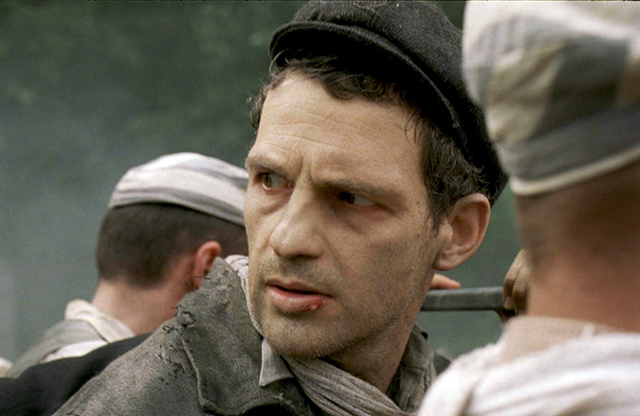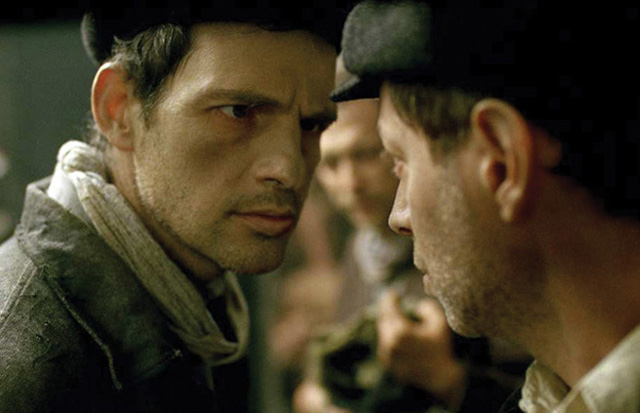CHICAGO – The Steppenwolf Theatre of Chicago continues to provide different viewpoints on the American stage, and their latest “Little Bear Ridge Road” is no exception. Featuring ensemble member Laurie Metcalf, it’s the resonate story of a family at the crossroads. For tickets/details, click LITTLE BEAR.
Personal Holocaust Horror is Rooted in ‘Son of Saul’
 Rating: 3.5/5.0 |
CHICAGO – The Oscar nominated, Golden Globe winning Best Foreign Language Film is a another trip into the well of horror that was the Holocaust. After over 100 movie treatments, director László Nemes finds a more personal story to tell, and it all unfolds in “Son of Saul.”
The telling and style of the film is its greatest strength. Director Nemes chose to present the circumstance through the “Academy” screen ratio (1.37 to 1, more square than a normal widescreen), and focuses on his main character Saul throughout his path in the story. This allows for the actor Géza Röhrig to use his character as a focus – all the pain, dread and numbness spill into the audience. This is harsh and difficult subject matter – with death being the norm – and little hope for the Jewish prisoners who both march to the gallows, or in the case of Saul, are forced to clean up the resultant corpses of the genocide. This is creative bitterness, valuable as art but draining as an experience.
Saul (Géza Röhrig) is a so-called “Sonderkommando” at the Auschwitz concentration camp in 1944. The term was given to the Jews who were forced by their Nazi captors to clean up and burn bodies after the many exterminations. This is literally a survivor position, as the unit were separated from the other captors, marked with symbols and given special privileges.

Géza Röhrig is Saul in ‘Son of Saul’
Photo credit: Sony Pictures Classic
Saul is like a sleepwalker, as followed through his horrid duties, until an event occurs that wakes him up. A boy has somehow survived the gas chambers, and is “killed” again. The “doctors” of the camp insist that the body be brought to their chambers for examination, but Saul suddenly plans other route. He sees the boy as his son, and steals the body to seek a proper Jewish funeral ritual. Around his journey, a revolt is being planned, and a liberation may be at hand.
This is an extraordinary use of cinema art to evoke an individual struggle during the most heinous of situations. The ides of focusing on the character of Saul, while utter horror and mass chaos goes on surrounding him, is a new and direct perspective on Holocaust terror. While Saul searches for something he almost knows he can’t find, behind him – in the narrow box of the screen ratio – the gas chambers are lit, the bodies are buried and the battle rages on.
The close-up perspective also keeps individuals in the center. The Sonderkommandos were dubbed the “keepers of secrets” for their role at the camps, and many of them wrote down what they were witnessing, and even photographed the killing scenes. They would hide these testimonials, with much of this material found buried after the liberation of the camps, and the film emphasizes this courage. What Saul wants – the proper burial of his “son” – is filtered through the chain of desperate souls, yet they continue to keep his task a secret.
Géza Röhrig, a part-time actor who hadn’t been in front of a camera in years, proves he was the perfect choice for this difficult performing assignment. His face is a placid and numb mask, his eyes darting constantly and sometimes giving away his true feelings. He claws his way through the rooms of death, a slice of hell on earth, going step-by-arduous-step towards something that he doesn’t know or anticipate – a purpose, yet a futility.

Confronting His Sorrow in ‘Son of Saul’
Photo credit: Sony Pictures Classic
The story itself is very hard to take, given the themes of childhood death, genocide, human desperation and blithe slaughter. The conclusion is like many other conclusions in the Holocaust film genre, “why was this allowed to happen?” The answer, now over seventy years old, is still blowing in the wind. As a culture and society, genocide still rages on, and maybe the real conclusion is those six million souls lost in the Holocaust didn’t teach humanity a damn thing.
And maybe that is why filmmakers and storytellers keep going back to the well of the Holocaust. No matter how many times the bucket goes in those waters, it always comes back up with a new context of war, death and mental disease, and is always blood red. We need those reminders – truly, madly and constantly.
CLICK HERE for an interview with director László Nemes and lead actor Géza Röhrig of “Son of Saul.” by Patrick McDonald of HollywoodChicago.com.
 | By PATRICK McDONALD |


